Pear Trees
There’s 3,000 varieties of Pear Trees. They were cultivated in China as far back as 2000 BC. Now, there are MANY varieties of pears. Our 5 best pear trees are a small sample-size. However, the 5 are well-known to gardeners, and grow well in the hot humid climate of Maryland! All 5 trees are listed below.
China prows 70% of the world’s pears. In American, Washington, Oregon and California are the top producing states. Pear trees like nice weather too! The Green Bartlett and D’Anjou pears are the most common pear varieties. Those are the pear you find in your grocery store.
Pears can be categorized in many ways. Gardeners usually categorize by them as European or Asian Pear trees.
Growing pear trees is easy. We grow them without using any chemicals spray. Amend the soil and little-to-NO water is needed a few years after planting. HEPPY™ is in Maryland (zone 7). After six years I can truly share what lessons we learned growing the Kieffer, Moonglow and Warren Pear trees. The Drippin’ Honey and Korean Giant pear trees were planted in 2023. Join us on YouTube as we share how we grow the 5 best pear trees!
See us on YouTube — please subscribe!
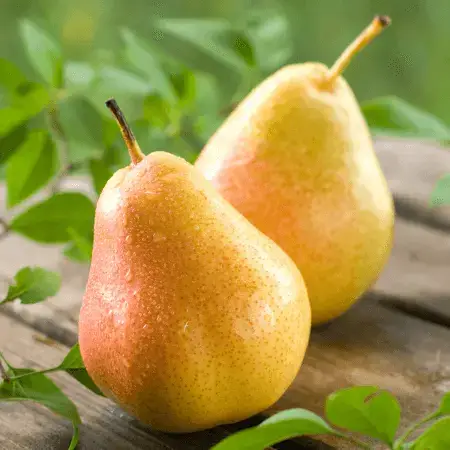
As an Amazon Associate, HEPPY earns from qualifying purchases (paid link).
What's the difference: Asian vs European Pear?
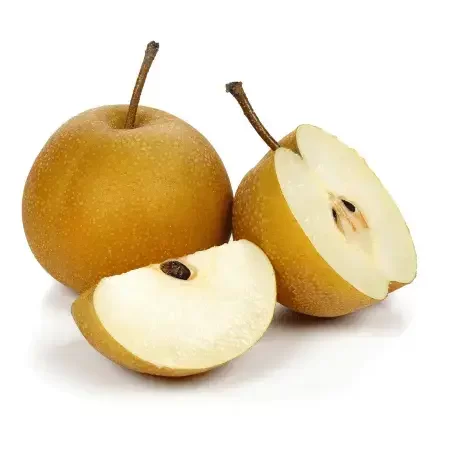
Asian Pear
Asian pear fruit is known for being sweet and crisp. They are best picked off the tree when ripe. The fruit stores well. These pears can be placed in the refrigerator for months.
Japanese and Chinese are two categories of Asian pear trees. The Japanese pear fruit are generally round and tan colored. The Chinese varieties are pear-shaped with green skin.
Asian pear trees are HEAVY producers, and the fruit are large. Thinning fruit is sometimes required. Thin fruit to one fruit per six inches to ensure higher sugar content, larger fruit and less stress on the tree.
Asian pear trees are also called, Apple Pear, Chinese Pear, and Chinese Sand Pear.
European Pear
European pear fruit have a soft texture and vary in juiciness. They are picked off the tree when hard. You have to consider the size and color of the fruit before picking. European pear ripen just like the store-bought fruit — on your kitchen countertop. Store fruit at room temperature and they’ll ripen. European cultivars vary in shape and juiciness, as
European pear trees are also heavy producers. The fruit’s shape is the classic, pear shape. However, fruit shape varies. Some varieties are a bit long and thin while others have a “fat bottom.”
How to Grow Pear Trees
In a nutshell:
Grow pear trees in full sun, and in soil that doesn’t stay wet ;). Buy varieties that are “Very resistant” or “Resistant” to Fire Blight.
Sun
All fruit trees prefer full sun. However, they can tolerate some shade. The pear tree is no different. Give pear trees and all fruiting trees at least 6 hours of sun (summer months).
Soil
Pear trees tolerate virtually all soils. However, they don’t want to wet soil. The best soil is well-drained soil with organic matter.
Soil should be slightly acidic, pH 6 to 7. We simply use well amended soil and don’t test pH. However, you can use a $13 pH test device.
Water
It depends but don’t overwater. When asked this question I wonder: How much rain have you had, heat events, and how well is the soil amended? We planted two Asian Pear in late spring and watered them ONCE after planting (2023). Why, despite having the hottest July on record? It rained regularly, and our soil is SUPER well amended. Rain, soil and timing are factors.
Pollination
Few varieties of pear trees self-pollinate. The Warren and Shinseiki self-pollinate. There are a few others. Also, some varieties of the Asian and European pear trees cross-pollinate. Finally, pear trees flower at different times. It’s a bit annoying to line-up every element. Confused? I can truly share that the Warren Pear Tree is the best for the home gardener.
Disease
Fire Blight is the predominate disease. We have little-to-moderate issue with it.
- Pear Varieties. Select varieties that are less susceptible to Fire Blight (“Very resistant” or “Resistant” are the keywords).
- Weather. The weather is a factor. Live with it ;). Some years, our pear trees have it, some years not.
- Prune. Prune away and discard infected twigs and fruit.
- Where you live and grow! Maryland can be wet and humid. On the other hand, the West Coast USA doesn’t know what humidity is 😉
- Fertilizer. Be careful to NOT use too much nitrogen. Nitrogen supercharges new growth which is susceptible to Fire Blight. Go permaculture / organic — all our ancestors did to grow food ;).
The USDA writes that these pear varieties are resistant to Fire Blight (all European varieties): Alexander Lucas, Blake’s Pride, Harrow Delight, Harrow Sweet, Honeysweet, Magness, Moonglow, Potomac, Tyson, and Warren. However, the Warren is FAR more resistant than the Moonglow, here at HEPPY™.
As an Amazon Associate, HEPPY earns from qualifying purchases (paid link).
Lessons Learned Growing Pear Trees
- Warren Pear tree is best.
- Large fruit, and the tree grows in a round shape (not as tall as the Kieffer and Moonglow). The Warren pear tree is by far the most disease resistant of the three. However, it produces about 1/2 to 2/3rds the volume of fruit (vs. the Kieffer & Moonglow).
- Kieffer is second best.
- Small fruit, and the tree grows tall. It is somewhat disease resistant. It is a very PROLIFIC fruiter.
- Moonglow is third best.
- Large fruit, and the tree grows very tall. It is the LEAST disease resistant of the three. The tree survives prefectly well. However, the fruit seems most affected by Fire Blight, or some other bacteria or fungus. It is a very PROLIFIC fruiter.
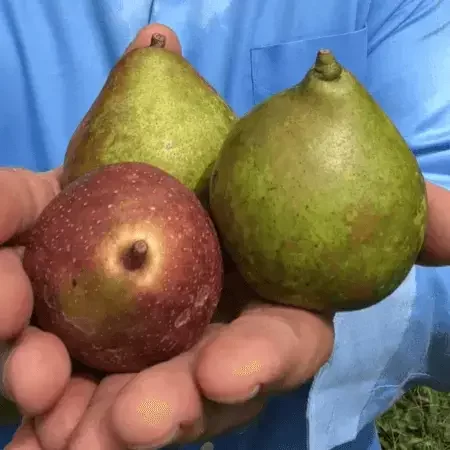
As an Amazon Associate, HEPPY earns from qualifying purchases (paid link).
5 Top Pear Trees for the Home Garden
1. Drippin' Honey Pear, Pyrus pyrifolia
I read many good things about the Drippin’ Honey pear tree. But finding it from one of my “mom & pop” nurseries was impossible. We bought ours from … a big box store.
Drippin’ Honey pear trees are known for producing large fruit. Also, it produces a lot of fruit. And the name says it all about the flavor — very sweet.
Our Drippin’ Honey pear tree was planted in 2023. It’s too early to evaluate its resistance to Fire Blight (to early to HEPPY-verify resistance :). There’s little credible information. However, I read that it is resistant. We’ll know within 2 years…..
Drippin’ Honey Pear Tree
Height: Dwarf (8-12′); Semi-dwarf (12-20′); & Standard (20-30′)
Fruit size: up to 1 pound!
Plant zone: 5-8
Remarks: a difficult-to-find tree (for sale, trade, scion); purchasing from a big-box store may be your only option.
We just planted our Drippin’ Honey pear tree in 2023. We’ll keep this page updated. You can also catch us on YouTube!

2. Korean Giant Pear, Pyrus pyrifolia
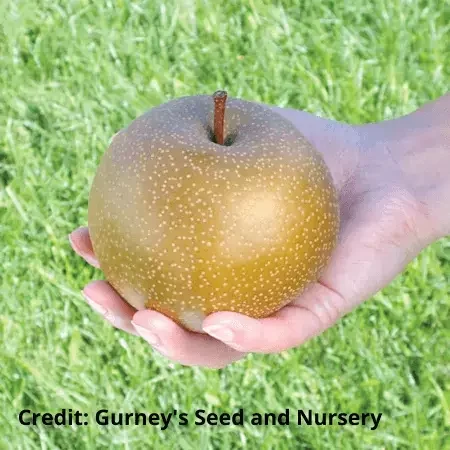
The Korean Giant pear are known for producing exceptionally large fruit. The pear fruit are round, and light brown, and grow as big as a grapefruit.
It is a late-blooming variety. However, it will cross-pollinate with most Asian and European pear trees.
Korean Giant pear is also called the Olympic, Large Korean, Dan Beh pear.
Korean Giant Pear Tree
Height: Dwarf (8-12′); Semi-dwarf (12-20′); & Standard (20-30′)
Fruit size: may exceed 1 pound!
Plant zone: 4-9
Remarks: a difficult-to-find tree (for sale, trade, scion); purchasing from a big-box store may be your only option.
We just planted our Korean Giant Pear pear tree in 2023. We’ll keep this page updated. You can also catch us on YouTube!
3. Kieffer Pear, Pyrus communis
Kieffer pear trees bear large crops of fruit. The fruit is golden-yellow with crimson blush skin. The white flesh is crisp and coarse. Fruit ripens from August to October, depending on your neck-of-the-woods. We begin picking in August, and let fruit soften in the house.
Six years after planting, we do not need to water or fertilize the Kieffer. However, pruning is done annually. We promote limbs to grow laterally. So pruning the new shoots growing straight up is an annual task.
I read that this variety is good for preserves, canning or baking.
It has good disease resistance to Fire Blight. Not as good as the Warren, but better than the Moonglow.
Kieffer Pear Tree
Height: Dwarf (8-12′); Semi-dwarf (12-20′); & Standard (20-30′)
Fruit size: a smaller sized pear
Plant zone: 4-9
Remarks: commonly grown tree. Grows fast. Kieffer is a good tree for a tight, sunny location but have a latter so you can pick the fruit 😉
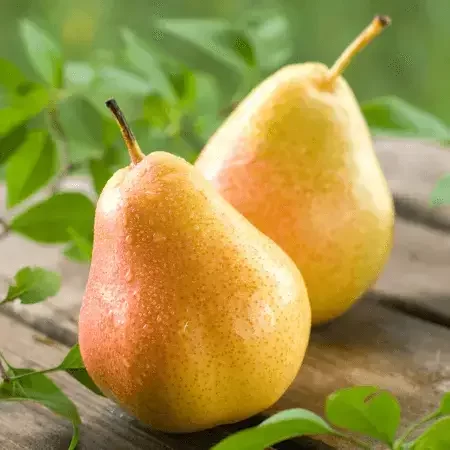
4. Moonglow Pear, Pyrus communis
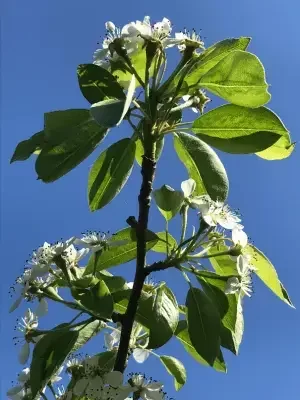
Moonglow pear trees bear large crops of fruit. Just like the Kieffer.
The fruit is golden-yellow with crimson blush skin. The white flesh is crisp and coarse. Fruit ripens from August to October, depending on your neck-of-the-woods. We begin picking in August, and let fruit soften in the house.
Six years after planting, we do not need to water or fertilize the Moonglow. However, pruning is done annually. We promote limbs to grow laterally BUT the Moonglow is very resistant. It wants to grow straight up!
It is listed as Fire Blight resistant. It survives great but the leaves and fruit are the most sensitive to bacteria and fungus. Of the Kieffer, Moonglow and Warren pear trees, the Moonglow is least resistant to bacteria and fungus disease.
Moonglow Pear Tree
Height: Dwarf (8-12′); Semi-dwarf (12-20′); & Standard (20-30′)
Fruit size: large pear
Plant zone: 4-8
Remarks: commonly grown tree. Grows fast. Moonglow is a good tree for a tight, sunny location but have a latter so you can pick the fruit 😉
5. Warren Pear, Pyrus communis
The Warren pear tree was named after T. O. Warren from Hattiesburg, MS. He found the tree at a pear test plot near his home and popularized the variety.
It is easily the BEST European pear we grow.
- Warren pear trees grow in a round shape, rather than shooting straight up like the Kieffer and Moonglow.
- The fruit is largest European pear we grow. The fruit has no blemishes.
- It is by FAR the MOST resistant to bacteria and fungus disease. We barely have leaf spots!
- It’s self-fertile!
However, you have to be patient. It was the slowest growing tree. It took a full 5 years for it to begin fruiting (5 years to begin producing more that 5-10 fruit). Also, it produces about 1/2 to 2/3rds the volume of of fruit (vs. the Kieffer & Moonglow). HEPPY™ is taking low care (very little pruning) and excellent, large fruit over volume. LOVE the Warren pear tree.
Warren Pear Tree
Height: Dwarf (8-12′); Semi-dwarf (12-20′); & Standard (20-30′)
Fruit size: large pear
Plant zone: 5-9
Remarks: the best European pear tree. Many remarks are very positive about this tree. It’s a no-brainer.

my favorite (as of 2023 ;)*** NOT an actual Warren pear but similar;am working on getting authentic pic
Major Pear species (wikipedia)
- Pyrus amygdaliformis—Almond-leaved pear
- Pyrus anatolica
- Pyrus armeniacifolia—Apricot-leaved pear
- Pyrus betulifolia—Birchleaf pear
- Pyrus boissieriana
- Pyrus bourgaeana—Iberian pear
- Pyrus × bretschneideri—Chinese white pear
- Pyrus calleryana—Callery pear
- Pyrus communis – European pear
- Pyrus cordata—Plymouth pear
- Pyrus elaeagrifolia—Oleaster-leaved pear
- Pyrus pseudopashia
- Pyrus pyraster—Wild European
- Pyrus pyrifolia—Nashi pear, Sha Li
- Pyrus regelii
- Pyrus salicifolia—Willow-leaved pear
- Pyrus × sinkiangensis—maybe hybrid
- Pyrus spinosa
- Pyrus syriaca—Syrian pear
- Pyrus ussuriensis—Siberian pear
- Pyrus xerophila
________________________________________
YouTube channel (please subscribe)

